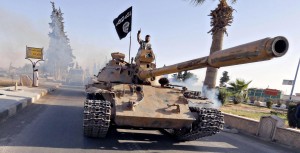May 21-27, 2015 Current Events Lesson Plan
Current Event: ISIS Gains Control of Ancient City of Palmyra
The terrorist group Islamic State (ISIS) recently captured the Syrian city of Palmyra. ISIS now controls more than half of the territory in Syria. Because Palmyra’s fall was sudden, the Syrian army was unable to put forth an orderly retreat, and many lower level troops and civilians were trapped. ISIS executed Syrian soldiers and people thought to be loyal to the government of Syrian President Bashar Al-Assad. In addition to the human tragedy, the fall of Palmyra gives ISIS control of important bases belonging to the Syrian army and highways linking various regions of Syria. Also, the ruins of the ancient city are designated a UNESCO World Heritage Site. Because ISIS has a history of destroying pre-Islamic art and architecture, preservationists fear the ruins may be lost.

Islamic State (ISIS) fighters during a military parade in Raqqa province in Syria. Credit: © Alamy Images
Objective:
Palmyra was an ancient Syrian city built around a desert oasis on an important trade route between the Roman and Persian empires. Traveling caravans stopped at Palmyra, bringing great riches and a variety of people and cultures. By the A.D. 160′s, Palmyra had come under Roman control. When Persia invaded Syria about 260, Rome had no troops to spare for Syria’s defense. Under Septimius Odenathus, a Palmyrene prince, Palmyrene forces turned back the invading Persians. In 262, Odenathus became Rome’s supreme military commander on the eastern frontier. He died in 267, and his widow Zenobia succeeded him. Zenobia tried to extend her rule over Egypt and all Asia Minor. Her troops seized land from Rome. But the Roman emperor Aurelian captured Zenobia in 274 and destroyed Palmyra. Emperor Diocletian partly restored the city in the late 200′s. In the mid-500′s, Emperor Justinian used it as a fortress to defend the eastern frontier against Persia. Palmyra fell into decline after Arab forces gained control in 637. The Behind the Headlines news story and related World Book articles explore Palmyra and other historical places.
Words to know:
Discussion Topics:
1. Syria is in the Middle East. Ask your students to name the Middle Eastern countries. (The 15 Middle East countries are Bahrain, Egypt, Iran, Iraq, Israel, Jordan, Kuwait, Lebanon, Oman, Qatar, Saudi Arabia, Syria, Turkey, the United Arab Emirates, and Yemen. The Gaza Strip and the West Bank are also in the region. Some people consider Afghanistan, Algeria, Cyprus, Libya, Morocco, Pakistan, Sudan, or Tunisia to also be in the Middle East.)
2. Ask your students what they know about Syria. (Students might say that Syria lies at the eastern end of the Mediterranean Sea; Damascus is the country’s capital; petroleum is one of the country’s most important natural resources; most Syrians are Muslim Arabs.)
3. Archaeology is the scientific study of the remains of past human cultures. Have your students debate the topic, “It is important to learn about people from the past.”
4. Ask your students to use World Book’s Timelines feature to create a timeline of the history of Syria. (Students may wish to use the history section of World Book’s Syria article for help.)


